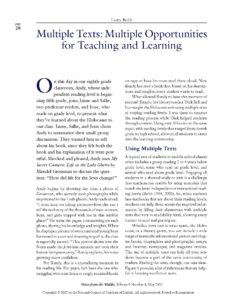Author: Laura Robb
Summary: Offering a vivid glimpse into her middle school classroom, author Laura Robb illustrates how making available a range of texts at different reading levels and from a variety of perspectives promotes student engagement and success in her heterogeneously grouped classroom. Robb also shares a list of sources for locating a range of nonfiction texts along with a variety of effective teaching strategies. Sharing both theory and practice, this article could be easily the basis for a single workshop session or a series of workshops demonstrating strategies for strengthening students’ content-area literacy skills.
Original Date of Publication: May 2002
On this day in our eighth-grade classroom, Andy, whose independent reading level is beginning fifth grade, joins Jaime and Sallie, two proficient readers, and Jesse, who reads on grade level, to present what they’ve learned about the Holocaust to our class. Jaime, Sallie, and Jesse chose Andy to summarize their small-group discussions. They wanted him to tell about his book, since they felt both the book and his explanation of it were powerful. Shocked and pleased, Andy uses My Secret Camera: Life in the Lodz Ghetto by Mendel Grossman to discuss the question: “How did life for the Jews change?”
Andy begins by showing the class a photo of Grossman, who secretly took photographs while imprisoned in the Lodz ghetto. Andy reads aloud: “I must keep on taking pictures—how else can I tell the real story of the thousands of men, women, boys, and girls trapped with me in this terrible place?” He turns the pages, commenting on each photo, sharing his knowledge and insights. When he displays a picture of two emaciated young boys harnessed to a cart and straining to pull it, the class is especially moved. “This picture shows how the Nazis made the Jews into animals and took their human beingness away,” Randy explains, his voice growing more confident.
For Andy, this is a crystallizing moment in his reading life. For years, he’s been the one who struggles, who must listen to tough, required books on tape or have his mom read them aloud. Now Andy has read a book that, based on his descriptions and insights, every student wants to read.
What allowed Andy to have this moment of success? Simple: his history teacher Dick Bell and I co-taught the Holocaust unit using multiple texts of varying reading levels. I was there to support the reading process while Dick helped students through content. Using over 50 books on the same topic, with reading levels that ranged from fourth grade to high school, allowed all students to enter into the learning community.
Using Multiple Texts
A typical mix of students in middle school classes often includes a group reading 2 to 4 years below grade level, some who read on grade level, and several who read above grade level. Engaging all students in a themed study or unit is a challenge that teachers can resolve by using materials that match students’ independent or instructional reading levels (Robb 1994, 2000). So, when students face textbooks that are above their reading levels, teachers can help them access the required information by filling their classrooms with multiple texts that vary in readability level, allowing every learner to read and participate.
Whether your unit is outer space, the Holocaust, or a literary genre, you can include a wide range of materials: informational picture and chapter books; biographies and photographic essays; and Internet, newspaper, and magazine articles. The use of multiple texts can help all your students become a part of the same community of readers. Finding the texts, though, can take time. Figure 1 provides a list of references that are helpful in locating nonfiction texts.
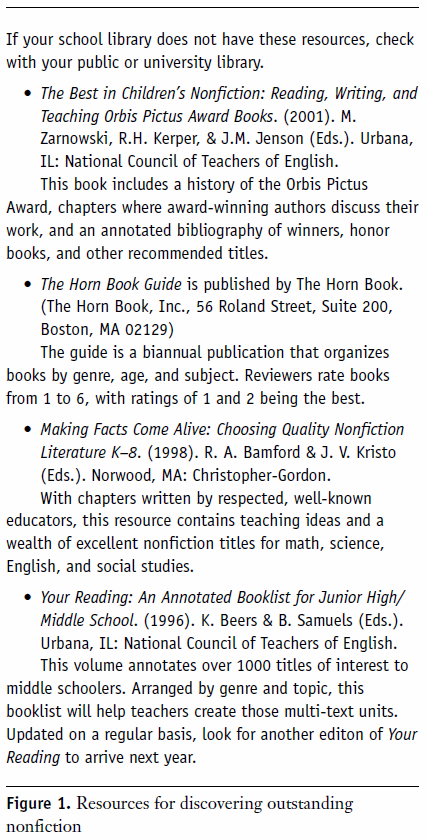
Once you’ve selected the range of texts you’ll share with students, spend some time in class dis- cussing the topic students will be exploring. If the topic is from a content area class, invite that teacher to lead those discussions. Spending valuable class time building your students’ background knowledge on the topic will save you time later. Be sure that this time doesn’t focus on fact sharing from you but instead centers on questions about the topic students generate. Encourage open-ended questions and list these questions on chart paper that can be kept on the wall so as students work through the unit, they can return to those questions and use them as a guide to prepare for small- and large-group discussions. Figure 2 shows the list of questions our eighth graders generated this year before reading anything about the Holocaust.
Once students know what they want to discover as they move through this unit, it’s time to help them choose materials they can read at an instructional or independent level. I do this by grouping easier material together in one area of the room, more difficult material in another area, and the most difficult in a final area. I direct students toward the texts I know will best match their instructional or independent reading level. Students choose one book they think they will enjoy, but they can return to that area at any time to choose an additional book. This system offers students some choice within a group of books they can read, think with, and enjoy.
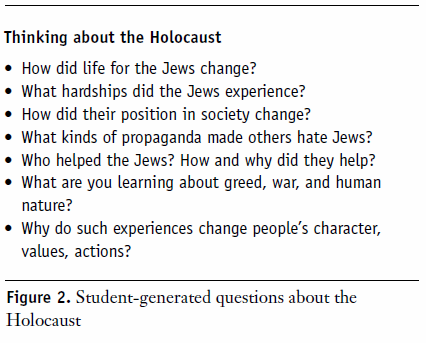
I negotiate with each student to determine a reasonable number of texts to complete. We make sure we set aside 20- to 30-minute blocks at least three times a week for reading and responding. Expository texts are filled with facts, so a good supply of sticky notes that students can post directly on the text as they read helps them keep up with their own comments as well as their questions, connections, and clarifications. These notes, as well as the questions the class generated prior to reading, later become springboards for paired and small-group discussions. While it’s important that students read texts that are at their independent or instructional level, the small-group discussions bring students of various reading levels together. As students read independently or meet in small groups to discuss their readings, I have the opportunity to individualize strategy lessons with brief, one-on-one meetings that address each student’s unique reading needs.
Multiple Texts and Individualized Strategic Teaching
At first I thought that using multiple texts would solve my students’ reading problems. Not true! While this approach did allow students to access information they otherwise couldn’t, it didn’t necessarily mean their comprehension strategies immediately improved. However, using multiple texts does allow me to adjust reading lessons and tasks to meet each of my student’s needs and offer everyone opportunities to improve because of individualized strategic teaching (Keene and Zimmermann, 1997; Robb, 2000; Wilhelm, 2001).
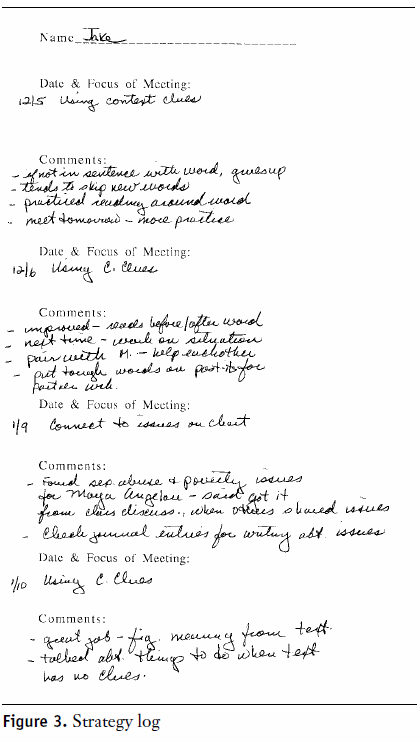
While my eighth graders read their Holocaust books, I hold short, one-on-one conferences. In one class period, I can meet with four to six students. To determine the strategic support each student needs, I observe students’ reactions to whole-class or small-group strategy lessons. Reading journal entries and listening to student-led discussions also provide valuable information on how students are applying strategies such as making connections, summarizing and synthesizing, or finding the main points.
A strategy log (see Figure 3) enables me to track the strategies each student practices during our mini-conferences. On a clipboard are the log sheets of students I plan to meet with while others read independently. I file logs in each student’s reading folder so I can refer to them when deciding what to address next.
Individualized Strategic Teaching Up Close
First I stop at Frances’s desk. She’s reading The Big Lie: A True Story by Isabella Leitner. Frances needs help finding and explaining cause and effect relationships. Using a passage from her book, I think aloud to explain how I found the cause and effect relationships in that passage. During the next two mini-conferences, I skim the text to find the cause and Frances skims to explain the effects. The fourth time we meet, I ask Frances to find a cause event and discuss the effects. Figure 4 provides a transcript of our conversation based on pages 34–35 of The Big Lie.
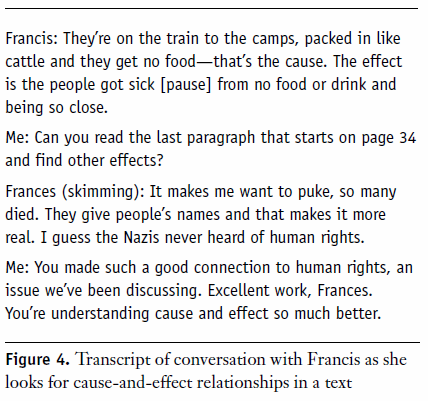
Next, I walk to Bobby’s desk. Bobby is a proficient reader. Using multiple texts permits me to stretch his ability to connect his book, Darkness over Denmark by Ellen Levine, to other texts he’s completed. First, I model how I connect this book to a recent read-aloud from Milton Meltzer, Rescue: The Story of How Gentiles Saved Jews in the Holocaust. Bobby immediately brings up No Pretty Pictures, an autobiography by Anita Lobel:
“There wasn’t a lot about resistance in Poland [in Lobel’s book], but there was a lot about rescuing Anita and her brother. Their nanny hid them in the country and then got them into a convent. I guess that is a kind of resistance—going against the Nazis and saving Jews. The Danes, like Leif Vido, stole weapons for the resistance from German soldiers. A big connection is that if you hid a Jew or hid weapons to resist the Nazis and they found out, you were finished. I guess there are different kinds of resistance.”
Then I move on to work with David, who needs help with selecting essential details, and Maria, who needs to practice using context clues to figure out the meaning of new words. Using multiple texts drives me to consider and meet the needs of individual students by helping them practice and apply reading strategies to texts they can read. So, not only do the reading materials become the grist for discussing varied interpretations of the same topic, they provide the opportunity for individualized strategic instruction.
Multiple Texts, Multiple Perspectives
Using multiple texts in a single unit has another benefit: students are introduced to multiple perspectives on a topic rather than being limited to the single view presented in any one text. According to Tunnell & Ammon (1996), multiple perspectives are “fundamental to good history teaching” (p. 212). I would extend this point to mean that when all studies—whether of science, human interactions, or issues as wide-ranging as preserving the environment and discrimination in our society—include multiple interpretations of events, they provide diverse perspectives for the discussion of social, political, and economic issues. Such diverse perspectives compel students to consider these questions:
- What really occurred?
- Are there other solutions?
- What do primary sources say?
- Is the author changing events and why?
- Did the author omit some events? Why?
- What’s the author’s agenda?
- Why were specific decisions made?
- Did others suggest different ways of dealing with issues?
- Why were alternate solutions abandoned?
- How did past decisions/discoveries/inven- tions affect our lives today?
Powerful conversations occur as students convene to discuss their various texts. The following transcription of three of my seventh graders illustrates that exposing students to varied perspectives through multiple texts may result in consideration of more diverse ideas and concepts than what might occur when using a single text. These three students read Drummer Boy by Ann Turner, descriptions of slave auctions from Chapter 12 of Uncle Tom’s Cabin by Harriet Beecher Stowe, and Chapter 1 of The Boys’ War by Jim Murphy. They discussed how the war affected children. Multiple texts enabled these students to make connections between boys sold into slavery and boys enlisting in the army, making them more aware of the drummer boy’s disillusionment.
JAIME: Stowe shows how fearful mothers were in a slave auction. Haley [a master] refuses to buy the mother with her son. It ends with the mother asking, “Couldn’t dey leave me one?” And they tell her to trust in the Lord. What good will that do? She’s alone with no one to love and love her.
RACHEL: Slaves had no rights.
KATIE: Yeah, like kids in the war. The boy was property, too. Murphy says in the first chapter that grown-ups writing about the war soon after it was over never mentioned the young boys fighting. Maybe no one wanted us to know about them. Lots of boys signed up and died before they had a chance to live.
JAIME: Do you think that could happen today?
KATIE: I’m not sure. I guess someone could forge papers. But they’d have to look older. These looked like ten or twelve.
RACHEL: In my book, a thirteen-year-old lies and signs up. He becomes a drummer boy and hears cannons roar, and the screams of shot horses and men crying for their mothers. Here [shows picture] the drummer boy is crying. He never expected war to be death—he thought it would be glory.
KATIE: War takes your childhood away.
JAIME: So does slavery. I think they’re alike. The drummer is a slave to the side he signed up for.
RACHEL: The men that took the boys—I blame them, too. They knew what war was really like. The slave auctioneers knew that families would be separated, people whipped and starved. But they still did it.
With the varied perspectives that reading different books offered, these students discussed important ideas and discovered what they believed and valued. As the group evaluated their conversation, I noted Rachel’s words because she captured the kinds of connections students can make: “The idea of slavery grew for me. I think our talk helped me see that the slavers and the men who took boys into the army had the same selfish values. I wouldn’t get all that from one book by myself.”
Closing Thoughts
Multiple texts enable teachers to offer students books they can read, improve students’ application of reading–thinking strategies, build confidence, and develop the motivation to learn. By using multiple texts, all students have the opportunity to learn new information and make meaningful contributions to discussions. Moreover, varied texts provide multiple perspectives that help students rethink events and issues that impact everyone and deepen their knowledge of literary genres.
Related Resources
Original Source: National Writing Project, https://www.nwp.org/cs/public/print/resource/2809
